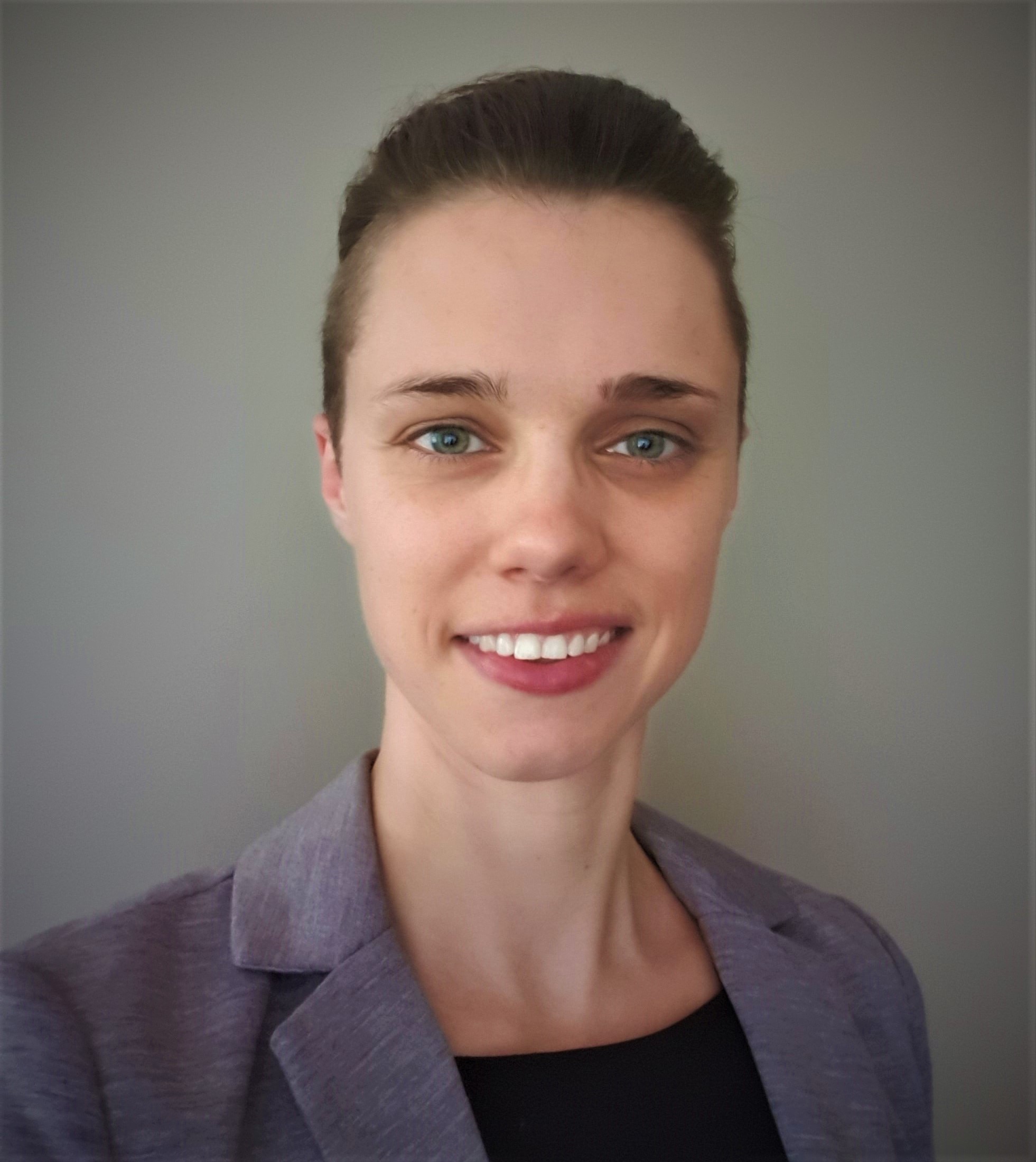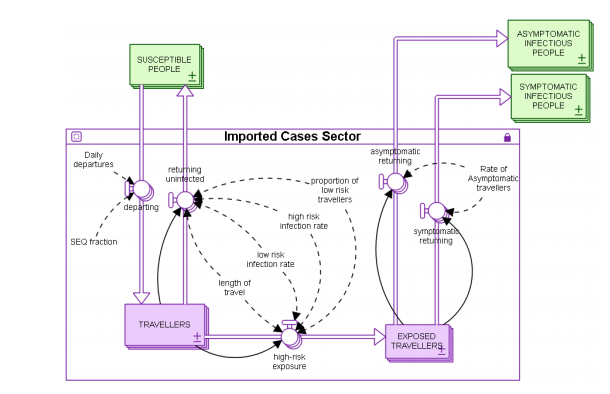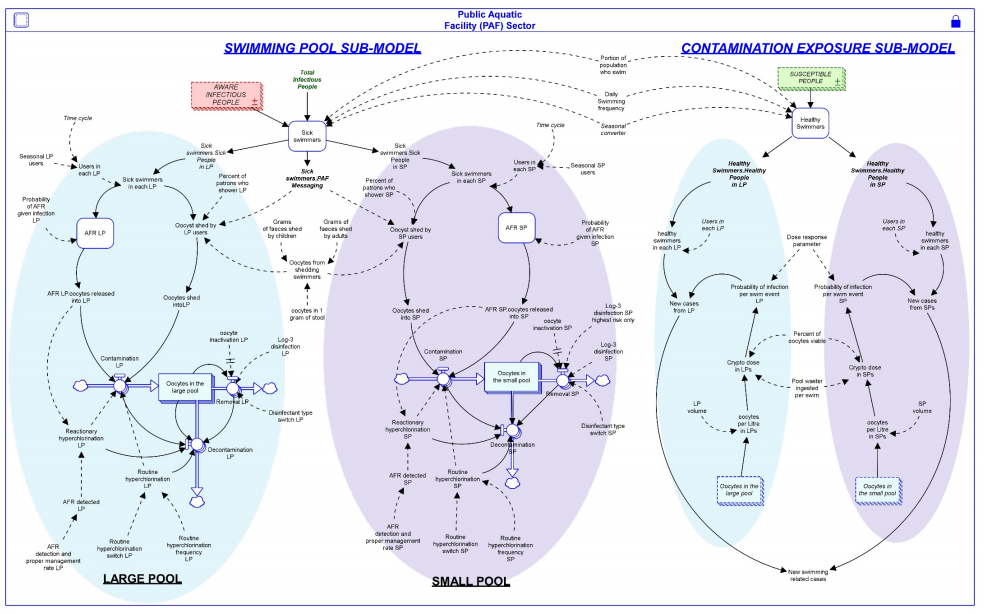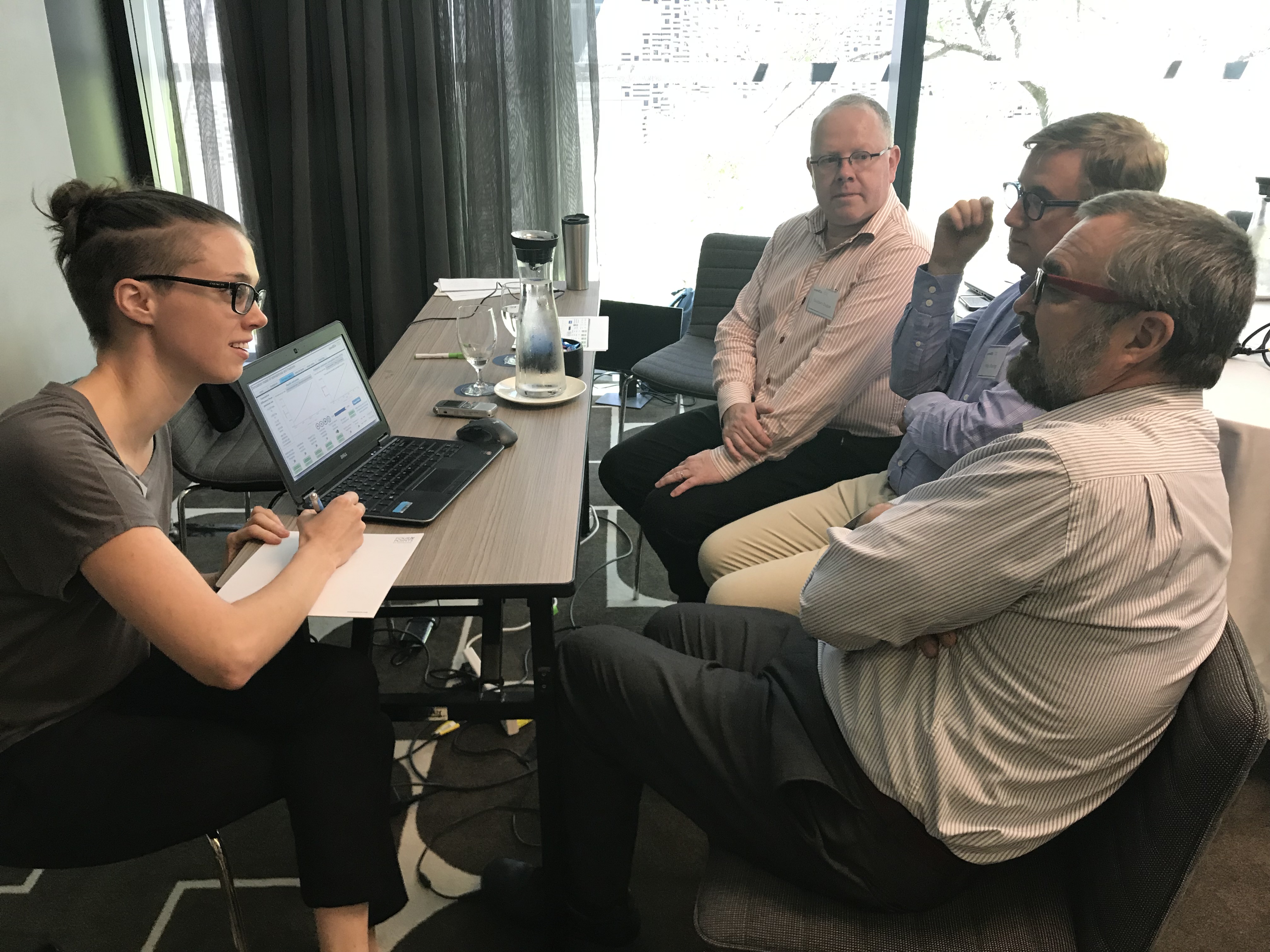Visualizing Evidence: How Systems Dynamicists At the Sax Institute Are Helping Decisionmakers Find Insights in Data
 Danielle Currie
Danielle Currie
Australia is a country of swimmers. Every child learns to swim and frequents school and municipal
pools throughout their lives. Unfortunately, while Australians are getting great exercise, they
sometimes come in contact with cryptosporidium, a fecal parasite spread by infected swimmers that
is resistant to levels of chlorine used for pool water disinfection. The result of cryptosporidium
infection is severe, prolonged diarrhea.
“Cryptosporidium is not particular to Australia,” says Danielle Currie, PhD, Senior
Simulation Modeller at Sax Institute in Sydney, Australia. “But because swimming is such an
important part of Australian culture and pools are effective transmission spots, it is a
public health problem.”
The investigation of cryptosporidium transmission in public pools was Currie’s first
experience in applied systems dynamics. Through a chance meeting with Carl Smith, PhD,
University of Queensland, Currie learned about both system dynamics and Stella® and
found a path to her own PhD dissertation and career.
“While working as an environmental officer for the Canadian government, I realized how
intertwined environmental and human health are,” says Currie. “I also saw how difficult
it was for decisionmakers to apply evidence to their questions. I do not have a background
in math or engineering and neither do most policymakers. Looking at screens of numbers and
code is mind numbing. Once I saw that nice-looking interfaces could be made using system
dynamics software and used to leverage data to develop shared insights, my path was set.”
After taking a year for self-teaching in system dynamics, Currie felt ready to apply her
knowledge to a real, current environmental health problem. She chose cryptosporidium
infection through pools from a list of options provided by local agencies. The result
was her dissertation, “Taking the ‘poo’ out of ‘pool’: Participatory systems modelling
as a decision-support tool for even the messiest public environmental health problems.”
“I developed a model based on pools in the Brisbane and Gold Coast region,” says Currie.
“Since Australians tend to visit multiple pools, transmission happens between
facilities. I used available disease rate data as well as data for pool use, doctor
visits, and dates of past infection outbreaks.”
Variables included the chance of accidental fecal release (AFR), chance of lifeguards
noting and reacting to AFR, and chance of other conditions that spur infection outbreaks.
“The model was able to match the documented trend in infection outbreaks which built
confidence that it reflected the problem and actual conditions,” says Currie.
Prior to seeing the model and simulations of different scenarios, decisionmakers thought
that cryptosporidium infections were cyclical and that current practice, e.g., shocking
pools with levels of chlorine high enough to kill parasites, could solve the problem.
The model, however, illustrated that the problem is random, rather than cyclical. “People
had remembered infection outbreaks as every three years or so but, with the model, we
could zoom out in time and see that outbreaks were random,” says Currie. “That meant
we could not treat pools on an understood cycle.”
“When we began the project, our goal was outbreak prevention,” says Currie, “The
insights gained through modeling and simulation completely shifted our thinking.
We couldn’t prevent outbreaks, but we could manage them.” Management required
understanding how the parasite was entering pools and what was happening when
people became infected.
“By talking to a lot of people, we realized that international travel was playing
a bigger role than expected in the transmission of cryptosporidium,” says Currie.
“Parasites are picked up in other countries, brought back to Australia, and
transmitted through swimming pool use. There’s no practical way to screen out
international travelers who might have picked up a parasite.”
 Stock and flow model of infection imported by travelers.
Stock and flow model of infection imported by travelers.
Currie and her project participants also realized the difference between small
pools and large pools. “Smaller pools used by younger children who are learning
to swim or elderly swimmers are more prone to AFR and can be shocked with high
doses of chlorine that do kill the parasite when necessary,” says Currie.
“While shocking is expensive and requires pool closure for a period of time,
it’s not a practical solution for large pools – but there is less chance of
AFR in pools used by fit adults.”
A critical mitigation action occurs outside of swimming facilities. “General
medical practitioners are usually the people that hear about cases of diarrhea,”
says Currie. “They might think that it’s a simple case and recommend that patients
stay away from swimming pools for a few days. But cryptosporidium infection is active
for two weeks. If advice to stay out of pools for that period of time is given early
enough, outbreaks can be more easily contained. Educating physicians and changing
the way they counsel patients was a key recommendation.”
 Stock and flow diagram of complete Public Aquatic Facility Sector.
Stock and flow diagram of complete Public Aquatic Facility Sector.
Currie’s dissertation experience helped participating local decisionmakers understand
a complex problem and discover real solutions. It earned the Lupina Young Researchers
Award and an Honorable Mention in the 2019 Dana Meadows Award from the System Dynamics
Society. For her ongoing work, it reinforced the importance of participatory model
building and visual presentation of information and insights, two features of the Decision
Analytics practice Currie joined at the Sax Institute, where work focuses on improving
efficacy of health programs and services.
“Clients see the benefit of system dynamics when they participate in its application
to their own project,” says Currie. “We follow a three-step process for participation
that includes clients, experts, and people with experience in every step of model
building, simulation running, and insight sharing.”
First, participants meet to introduce and scope out the project. “We roll out butcher
paper, draw a conceptual map, and ask ‘What is the problem?’ and ‘What are the main
factors?’. We also list any intervention ideas. We know that by the time a project
comes to us, several interventions are already on the table and want to be sure that
the model allows us to consider them.”
Currie then spends about a month or two building a draft model before the whole group
meets for the second step. “Together, we work through every step of the model,” says
Currie. “The model builder has to be humble and take in all feedback. I’m not a problem
expert but someone who can translate expertise and feedback into modeling language and
structure.” Interventions are more discretely defined so that they can be cost analyzed.
The third meeting is held after the model has been edited to include feedback and
intervention details. “We work through the interface,” says Currie. “Participants
actually sit in front of computers and use the model. Participants are new to system
dynamics and have never used Stella but they know what’s under the hood. They’re able
to use sliders, change assumptions, and look for collective aha moments.”
 Currie discusses the model with stakeholders.
Currie discusses the model with stakeholders.
Between each step are many questions, discussions, and model reviews. “By the time we
get to the end of the project, every participant has seen and commented on the model
a lot,” says Currie. “With that high level of participation, we get a very balanced
view of a problem. For example, when we model health concerns like cardiovascular
disease or osteoporosis, we’re able to build in feedback from health agency
officials, physicians, researchers, and patients to deliver insights that they
all understand.”
Currie and her Sax Institute colleagues have developed over 20 models using Stella,
engaging clients and participant groups in investigations of heart disease, suicide,
smoking rates, alcohol consumption, gestational diabetes and other, complex, public
health issues. Engagement in modeling, Currie explains, depends on having engaging models.
“Sixty percent of effective system dynamics is dependent on what’s inside the model,”
says Currie. “Forty percent depends on how it looks. Using Stella’s animation feature,
I’ve upped our visualization game. Models look very professional but, even more
important, they’re accessible to people who are new to system dynamics. Including
an animated beating heart in a cardiovascular disease model, for instance, doesn’t
add important information, but it does tailor the model to participants’ interests
and concerns, and encourages them to dig in.”